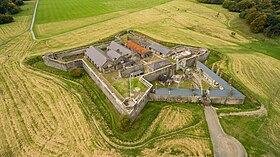Magazine Fort
| Magazine Fort | |
|---|---|
| Dún na hArmlainne | |
| Near Phoenix Park, Dublin in Ireland | |

Aerial (drone) image of Magazine Fort
|
|
| Coordinates | 53°20′55″N 6°18′59″W / 53.3486°N 6.3163°WCoordinates: 53°20′55″N 6°18′59″W / 53.3486°N 6.3163°W |
| Type | Bastion fort and magazine |
| Site information | |
| Owner | Office of Public Works |
| Open to the public |
Partial |
| Condition | Somewhat derelict |
| Site history | |
| Built | 1735 |
| Built by | John Corneille (military engineer) |
| In use | 1980s (demilitarisation) |
| Events | Easter Rising (1916), Christmas Raid (1939) |
| Garrison information | |
| Occupants | British Armed Forces, Irish Defence Forces |
The Magazine Fort is a bastion fort and magazine located within the Phoenix Park, in Dublin, Ireland. Built in 1735, it was occupied by British Armed Forces until 1922 when it was turned over to the Irish Defence Forces after the Anglo-Irish Treaty. The Irish Army continued to operate the site as an ammunition store through the mid-20th century. It was fully demilitarised by the 1980s. The fort is now managed by the Office of Public Works. As of 2015, it was in a derelict state and not open to the public, however some repairs were undertaken and the site partially opened for "limited guided tours" during 2016.
In the 1530s, during the Dissolution of the Monasteries, lands within what is now the Phoenix Park were confiscated from the Knights Hospitaller. These lands were later leased to Sir Edward Fisher. By 1611, Fisher had built a house known as "Phoenix Lodge" on St Thomas' Hill. By the mid-17th century, Fisher's house and lands were returned to the state, and the house used as the seat of the Lord Deputy of Ireland.
Although Thomas Burgh (1670–1730) had engineered a larger earthwork star fort quite close by in 1710, by the 1730s, the then Lord Lieutenant, Lionel Sackville (1688–1765) directed that a new gunpowder store be built at St Thomas' Hill on the site of the house. Phoenix Lodge was therefore demolished in 1734, and construction on the magazine fort commenced in 1735 to designs by engineer John Corneille. At the time the city was relatively poor, prompting the satirist Jonathan Swift to publish a verse on the seeming futility of the fortification:
...
Wikipedia

